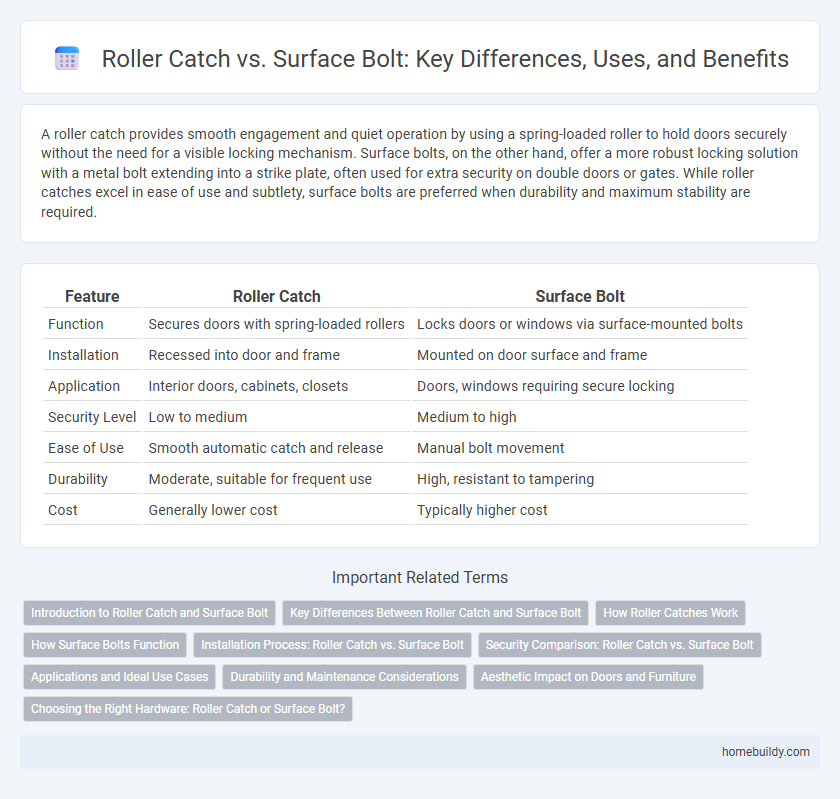A roller catch provides smooth engagement and quiet operation by using a spring-loaded roller to hold doors securely without the need for a visible locking mechanism. Surface bolts, on the other hand, offer a more robust locking solution with a metal bolt extending into a strike plate, often used for extra security on double doors or gates. While roller catches excel in ease of use and subtlety, surface bolts are preferred when durability and maximum stability are required.
Table of Comparison
| Feature | Roller Catch | Surface Bolt |
|---|---|---|
| Function | Secures doors with spring-loaded rollers | Locks doors or windows via surface-mounted bolts |
| Installation | Recessed into door and frame | Mounted on door surface and frame |
| Application | Interior doors, cabinets, closets | Doors, windows requiring secure locking |
| Security Level | Low to medium | Medium to high |
| Ease of Use | Smooth automatic catch and release | Manual bolt movement |
| Durability | Moderate, suitable for frequent use | High, resistant to tampering |
| Cost | Generally lower cost | Typically higher cost |
Introduction to Roller Catch and Surface Bolt
Roller catches provide a smooth, self-latching mechanism ideal for cabinet doors and lightweight panels, using spring-loaded rollers to securely hold the door in place without the need for a separate locking action. Surface bolts, typically mounted on the interior surface of doors or cabinets, offer a more secure and visible locking option by manually sliding a bolt into a catch or strike plate, often used on closet doors or double entry doors for added stability. Choosing between a roller catch and surface bolt depends on the desired balance between convenience, security, and aesthetic integration with the door design.
Key Differences Between Roller Catch and Surface Bolt
Roller catches use a spring-loaded roller mechanism to secure doors, providing smooth operation and easy engagement without visible hardware, ideal for lightweight or cabinet doors. Surface bolts rely on manually operated metal rods that slide into a strike plate or floor, offering stronger physical security suitable for heavier doors or extra reinforcement. Key differences include the roller catch's concealed design and convenience versus the surface bolt's mechanical strength and application for enhanced door stability.
How Roller Catches Work
Roller catches use a spring-loaded roller mechanism to hold doors securely while allowing easy opening with moderate force. Unlike surface bolts that require manual engagement, roller catches automatically latch when the door is closed due to the roller compressing against a strike plate. This self-latching feature enhances convenience and reduces wear, making roller catches ideal for lightweight interior doors.
How Surface Bolts Function
Surface bolts function by sliding a metal rod into a strike plate or hole mounted on the door frame or adjacent surface, providing a secure point to lock or stabilize doors and windows. Unlike roller catches that use a spring-loaded wheel to latch doors, surface bolts require manual operation to extend or retract the bolt, offering enhanced security and stability. These bolts are commonly installed on double doors, cabinets, or French doors where additional locking points are needed.
Installation Process: Roller Catch vs. Surface Bolt
The installation process for a roller catch typically requires precise alignment of the catch and strike plate to ensure smooth engagement, often involving mortising into the door or frame for a flush fit. In contrast, a surface bolt installation is more straightforward, as it mounts directly onto the door surface with screws, eliminating the need for recessing. Both methods demand accurate measurements, but roller catches generally require more skill and time due to their embedded nature compared to the surface-mounted simplicity of surface bolts.
Security Comparison: Roller Catch vs. Surface Bolt
Roller catches provide moderate security by holding doors closed with a spring-loaded mechanism, but they do not fully prevent forced entry. Surface bolts offer enhanced security by physically locking a door in place with one or two metal bolts that extend into the frame or floor, making unauthorized access more difficult. For applications requiring higher security, surface bolts are preferred due to their robust locking ability compared to the lighter holding force of roller catches.
Applications and Ideal Use Cases
Roller catches are ideal for lightweight interior doors, cabinets, and closets where frequent, noise-free latching is needed without a locking mechanism. Surface bolts excel in securing double doors, gates, or cabinets by providing strong manual locking and added stability. Applications favor roller catches for ease of use and subtle engagement, while surface bolts are preferred for enhanced security and durability in heavy-duty settings.
Durability and Maintenance Considerations
Roller catches offer superior durability compared to surface bolts due to their internal spring mechanism, which reduces external wear and tear. Maintenance for roller catches is minimal as they require less frequent adjustments and are less prone to misalignment issues. Surface bolts often need regular lubrication and tightening to maintain security and functionality, leading to higher upkeep over time.
Aesthetic Impact on Doors and Furniture
Roller catches provide a sleek, minimalistic look by being mostly concealed within the door or cabinet frame, preserving the door's clean lines and overall aesthetic appeal. Surface bolts, mounted visibly on the door surface, can disrupt the smooth design with their bulkier, more prominent hardware presence. Choosing roller catches enhances the visual harmony of modern and contemporary furniture designs, whereas surface bolts often suit rustic or industrial styles where hardware visibility is desired.
Choosing the Right Hardware: Roller Catch or Surface Bolt?
Selecting the appropriate hardware depends on door functionality and security needs; roller catches provide smooth latching with minimal visible parts, ideal for interior doors requiring frequent opening and closing. Surface bolts offer superior security and are suited for doors needing extra reinforcement, such as exterior or closet doors. Understanding the balance between ease of use and strength ensures the choice aligns with both operational demands and aesthetic preferences.
roller catch vs surface bolt Infographic

 homebuildy.com
homebuildy.com